Huge amounts of garbage are a global problem that you are surely aware of. Dream beaches full of trash, garbage swirls in the ocean, and pictures of turtles swimming in plastic are unfortunately part of our everyday life. And it is getting worse! According to the World Bank, the current amount of waste will increase by another 70 percent (!) to 3.4 billion tons by 2050. We can only guess what the consequences will be. Following you find some Zero Waste Travel tips.
In this blog post, we will take a closer look at the waste problem and tourism as a contributor. We look at possible solutions and practical examples: There is a better way!
How much waste do we produce globally?
In 2022, Statista published figures on global waste generation based on World Bank estimates for 2030 and 2050. Not surprisingly, the richest and most productive countries produce the most waste. The negative trend is led by the U.S., which already produced 289 million tons of waste per day (!) in 2016. (Projections for 2050 are 396 million tons per day.) China follows. Germany is in 5th place.
Waste in tourism
According to the German Hotel and Restaurant Association (DEHOGA), each hotel guest produces the following waste per day
In 0 to 2 star accommodations: 9.1 liters
In 3-star accommodations: 4 liters
In 4-star accommodations: 3.4 liters
5-star accommodations: 3.7 liters
According to DEHOGA, disposable packaging is the main reason why better hotels produce less waste. In an inexpensive hotel with few staff, it is easier for the operators to serve you packaged coffee cream than to serve you coffee cream in a nice porcelain jug.
At the SCHWARZWALD PANORAMA wellness hotel in Bad Herrenalb, Germany, the breakfast buffet does not use single-serve packaging. Instead, there are alternatives that are not only more sustainable but also much nicer: e.g. butter churns, glasses, and wooden bowls.
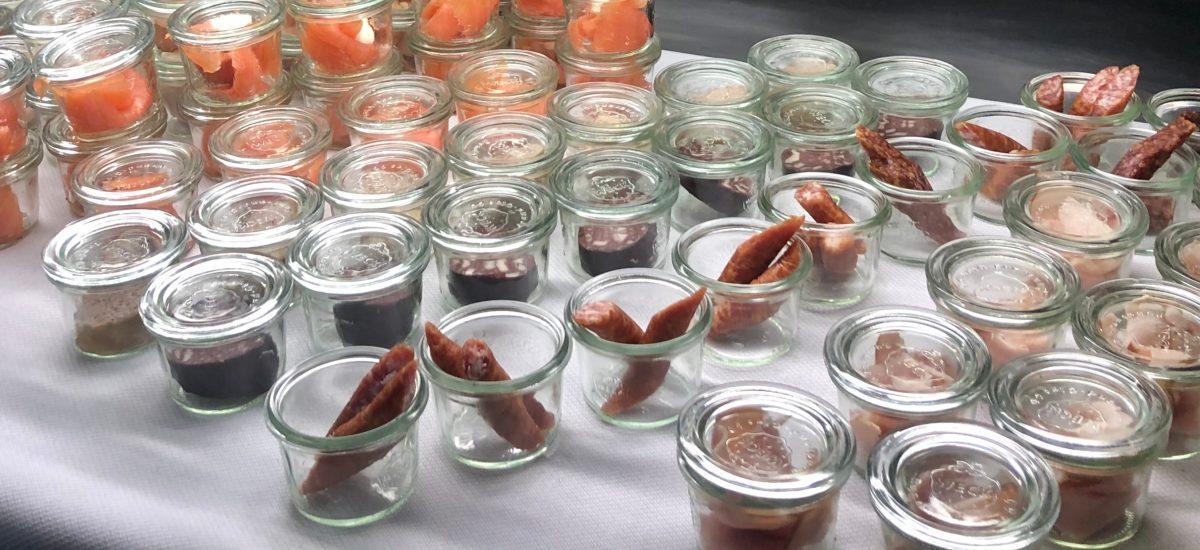
INFO: Buffets produce more waste than table service, which is why many sustainable hotels changed to a la carte. But there are resorts that are thinking even further about reducing waste and food waste when it comes to the a la carte menu. At CERVO Mountain Resort, Zermatt, Switzerland, service staff are trained to recommend sometimes smaller portions.
Sustainable hotels, and in particular our Green PearlsⓇ partners, are generally characterized by the avoidance of disposable packaging. For example, at the Berghotel Rehlegg in the heart of the Berchtesgaden Alpine National Park, Germany, only bar soap and shampoo bars are used in the rooms. The sustainable “villa wonderland“ Keemala in Thailand is proud not to have served a single plastic bottle or plastic straw since 2015. By 2023, the resort on Phuket saved 20,000 plastic straws and 50,000 plastic bottles.
Fighting the slipper mountain
There’s a new initiative to reduce waste at the vegetarian/vegan hotel Paradiso Pure.Living in South Tyrol. As part of the Italian hotel’s wellness program, each guest was provided with a pair of slippers for their stay, resulting in a mountain of slipper waste each season. Now you’ll be asked to bring your own slippers when you confirm your reservation. If you forget (or can’t squeeze them into your suitcase), you can still get slippers on request at the Paradiso Pure.Living reception – but only recyclable slippers for the dry area.
At the Weihrerhof on the Ritten and the Hotel Bella Vista Zermatt, you’ll also only receive slippers provided by the hotel upon request. Instead, these two hotels also encourage guests to bring their own slippers, flip-flops or slippers.
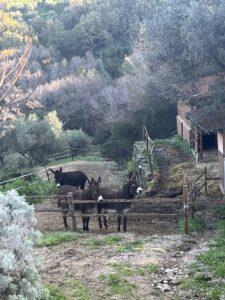
Waste separation and recycling for greater sustainability
In addition to eliminating disposable packaging, the German DEHOGA association’s recommendations for sustainable management include separating waste to recycle valuable resources and reduce residual waste.
At Relais del Maro, Elena Scalambrin, who converted the old houses in her childhood village of Borgomaro, Italy, into the sustainable 4-star Albergo Diffuso, has made sure that guests also have the opportunity to separate waste. There are recycling bins in every room. In the rooms, however, there is hardly any waste to separate anyway. There are no products with plastic packaging.
Further south, at A’ Cràpa Mangia in Campania, all apartments have a sea view – and four bins for waste separation: paper, plastic, residual waste and organic waste. Glass bins are in the parking lot. The donkeys and goats on the estate, which give the hotel its name, are also happy about leftover vegetables 🙂.
The Hotel SCHWARZWALD PANORAMA distinguishes between 13 different categories of waste. These include corks and candle wax, which are upcycled.
Not enough recycling
Very little plastic waste is recycled. This is partly because many composite materials are difficult to recycle (for example, sneakers are made of up to 40 different materials that are glued together). In Europe, the figure is around 30%, in China 25% and in the USA only 9%. According to the EU Parliament, most plastic waste is incinerated. This is called “energy recovery”, but it ensures that
– the resources used (petroleum) are lost
– massive CO2 emissions (WWF Australia estimates that over 850 million tons of greenhouse gases are released into the atmosphere each year from the production and incineration of plastic. By 2050 this could be 2.8 billion tons).
According to the EU Parliament, about 50% of the plastic collected in Europe is exported to non-EU countries – and not recycled. So the plastic on those polluted beaches I mentioned earlier could be your trash or mine!
The rest of the waste is either incinerated or dumped in landfills. Instead of a sustainable mindset, this is more of an “after me, the tide” attitude. Leave it to the next generations …
Plastic in the ocean – microplastics in food
The German Federal Environment Agency calls plastic in the oceans “one of the most urgent problems”. According to the report of the 5th United Nations Environment Assembly (UNEA) in Nairobi, marine plastic has already been shown to affect the reproductive capacity of marine life. It also disrupts the marine food chain and inhibits the activity of certain marine animals. However, the full extent of the problem is not yet known.
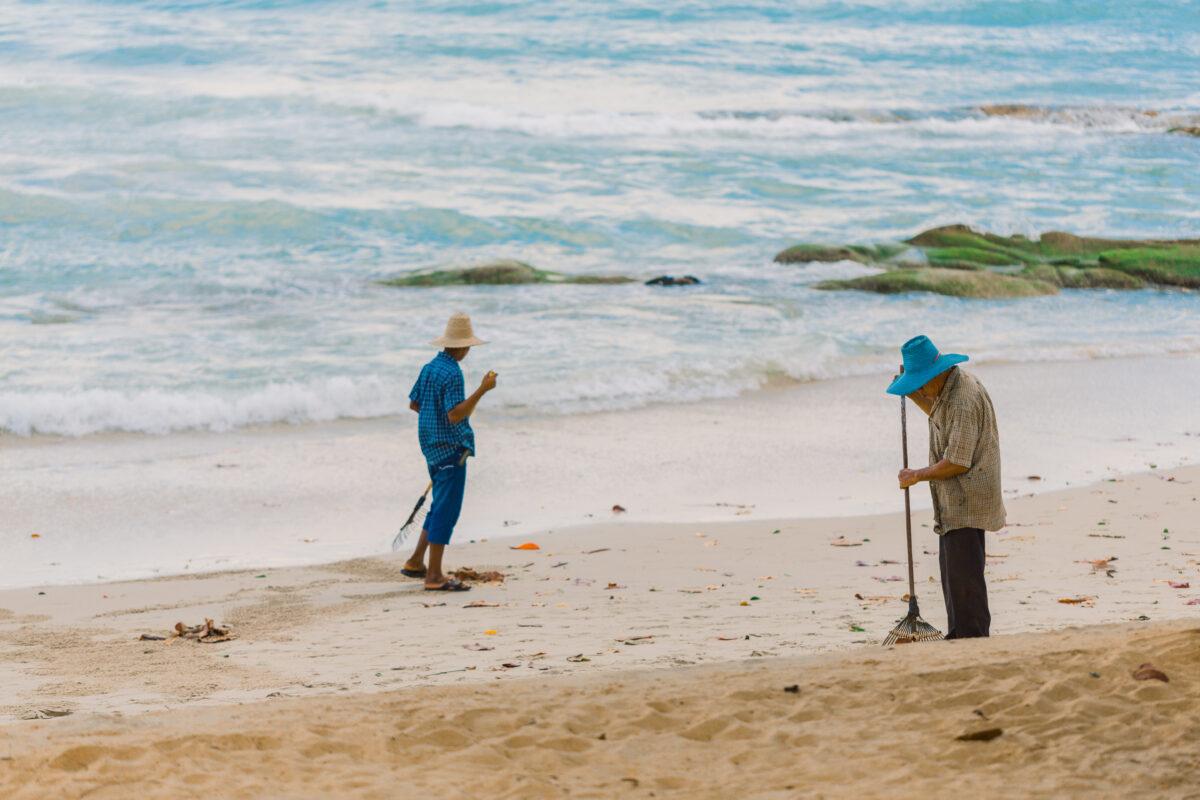
Beach cleaning activities of ADLER Spa Resort SICILIA and Zeavola, Thailand
The ADLER Spa Resort SICILIA and its employees clean the public beach in front of the hotel at least once a week along the entire 5-kilometer stretch of coastline. The sustainable luxury resort is located on the edge of the WWF’s Riserva Torre Salsa nature reserve and has worked closely with the local community and the WWF since its construction.
Although the beaches are public, they are hardly visited by tourists because they are difficult to access (except from the ADLER Spa Resort SICILIA). As a result, garbage comes almost exclusively from the sea. Once collected, it is sorted as much as possible by the staff. If after storm tides a lot or unusual garbage is washed ashore, the resort has it collected as special garbage.
The luxury dive resort Zeavola on Koh Phi Phi in Thailand even cleans the beach daily with its staff. In addition, Zeavola staff go on special underwater dives to clear the coral reefs of trash. The collected trash is taken to Phuket by Zeavola for incineration.
Problem: Microplastics
Plastic does not decompose. Instead, it breaks down into smaller and smaller particles that are invisible to the naked eye. But microplastic particles are not only created by the breakdown of larger pieces of plastic, they also end up in the air, for example, from tire abrasion, from washing synthetic clothing into the sewer, or from plastic water heaters into your tea water.
Microplastics in tea
In 2019, there was an interesting German study from the Department of Water Chemistry that looked at the formation of microplastics in kettles. It found that while glass kettles did not produce microplastics, plastic kettles contain between 10 and 29 million microplastic particles in just one liter of water.
The above study also states that tiny particles of microplastics (>150 microns) can enter our blood and even travel through the bloodstream to the brain or, for example, to a fetus in the womb.
Consumer power felt in microplastics
Although microplastics are currently classified as “harmless” (which is why even leading German consumer magazines such as Öko Test and Stiftung Warentest do not include them in their tests), you have probably noticed that more and more products advertise that they are “free of microplastics”, or you are told that food (e.g. water bottles and lunch boxes) “does not come into contact with plastic”. You may already be paying attention to this when you choose products.
As consumers, we have become much more critical of microplastics, and companies are responding by changing their production processes or developing new products. This shows that we as consumers can make a difference.
Going plastic-free at the hotel
Microplastics can be found in cosmetics, such as liquid soap or scrubs, and end up in our water cycle. Certified natural cosmetics do not contain petroleum-based plastics, so you’re already on the safe side.
Organic cosmetics in sustainable facilities
Some of our Green PearlsⓇ accommodations, such as the Gut Nisdorf family resort on the Baltic Sea, are BIO HOTELS and use the Miila mi organic cosmetics line, which is offered to all BIO HOTEL partners in the refill system. It is vegan, cruelty-free, and microplastic-free.
Gut Nisdorf orders the products in 3-liter bags and then fills them into the 300-ml refill bottles at the accommodations. Individually packaged goodies are no longer used.
Berghotel Rehlegg even has its own line of organic natural cosmetics made from local herbs.
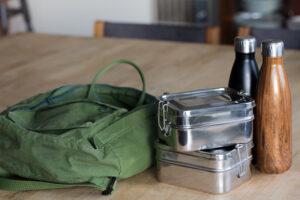
Zero Waste Travel
The Zero Waste movement has pioneers like Bea Johnson and Shia Su, who produce no more than one jar of waste in a year. In books and blogs, they explain how to shop without packaging (as a consumer), organize your bathroom and kitchen according to the Zero Waste principle (steel razors instead of disposable razors, solid shampoo instead of liquid shampoo from plastic bottles, washable dishcloths instead of sponges, washing nuts instead of detergent, etc.).
Zero waste while traveling – is it possible?
What works at home can usually be implemented when traveling. Depending on your destination, this may be easier or harder. However, you can now find unpackaged grocery stores almost everywhere. Or you can immerse yourself in the marketplace of your destination, experience the authentic flair, and support the local people directly.
Note: In some countries, such as Palestine, it is against the culture to show your purchases. Background: Poorer people might feel sad or envious. So, burlap bags – yes, groceries on your arm – no.
Zero Waste Travel Tips from Bea Johnson
When it comes to Zero Waste travel, Zero Waste icon Bea Johnson recommends the first of her 5 R’s (Refuse / Reduce / Reuse / Recycle / Rot). To her, “refuse” means consistently rejecting anything that creates waste. On an airplane, for example, she takes her own sandwich and fills her refillable thermos with tap water after security. That way, she says, she can refuse packaged airplane food and drinks in disposable cups on the plane. Her conviction: If more and more people do this, there will soon be a “zero waste menu” on airlines!
Zero waste at the hotel
Many of our Green PearlsⓇ partners have their own farms, so there is no packaging waste for fruits, vegetables, and herbs. Kitchen waste is also sustainably composted on the property.
Gut Guntrams near Vienna has already managed to reduce the total waste of their three exceptional vacation accommodations, including restaurant and agriculture, to only about 1200 liters per month (40 liters per day). (For comparison, the DEHOGA calculation – in a 2-star hotel there are already 9 liters of waste per day for a single guest).
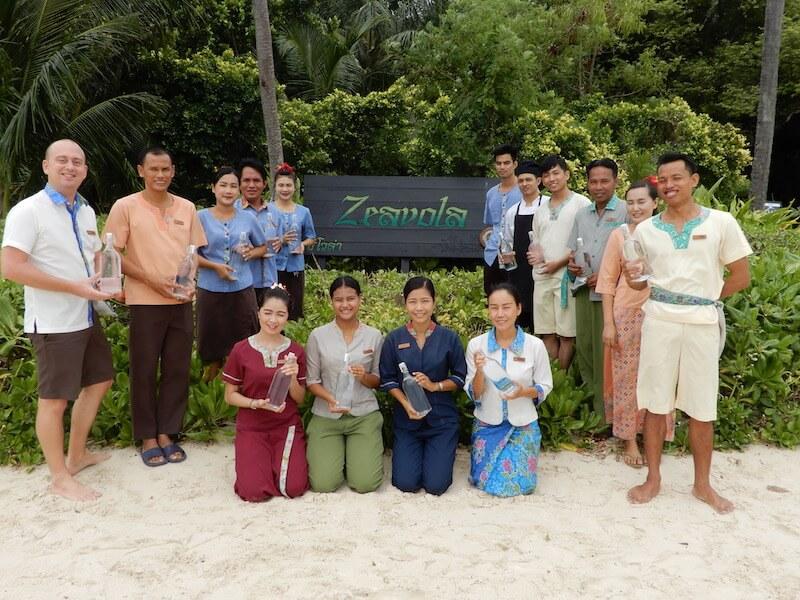
5 tips on how to make zero waste travel a reality
- Take a refillable water bottle. Many of our Green PearlsⓇ accommodations offer excellent drinking water from nearby mountain springs, have in-house filtration systems, or offer Grander water. Learn more about our partners’ drinking water projects in this article.
- Pack a lunch box. This will hold a sandwich for the trip, and you can use it to pack lunches for your excursions on the way. Beeswax wipes are also a good way to wrap food for the road.
- Always have a cloth bag for groceries and garbage bags from stores. If you can’t avoid it, reuse plastic bags for shopping or to keep shoes out of your suitcase.
- Use wood/bamboo/miswak toothbrushes and use toothpaste tabs instead of tube toothpaste.
- Book sustainable accommodations 🙂 These avoid single-use plastics, ensure proper waste separation, and otherwise take care of the environment wherever possible.
This list is certainly not exhaustive. So, we’re interested in your ideas – how else can you go zero waste on your travels? What are your experiences? We look forward to hearing from you and working together to reduce the enormous amount of waste on our planet.
Save this article for your next adventure.
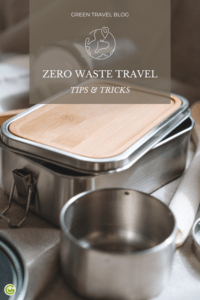

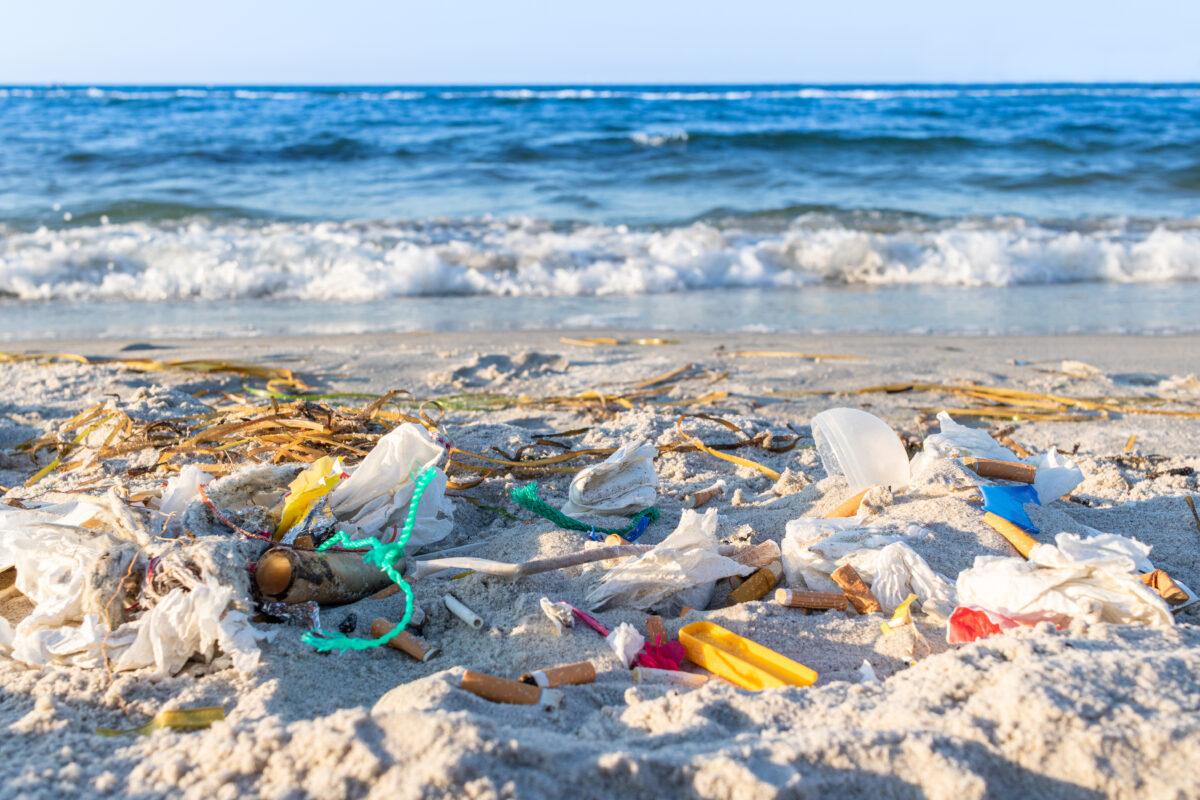


 (3 votes, average: 3.67 out of 5)
(3 votes, average: 3.67 out of 5)
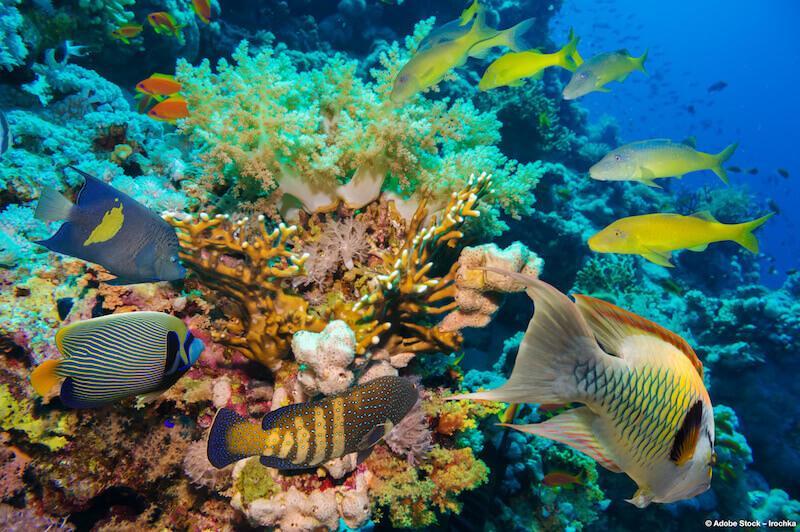

4 thoughts on “Waste Prevention in Tourism and Zero Waste Travel Tips”